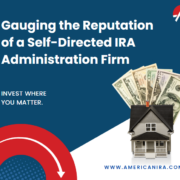Protect Yourself from Bear Markets Using Self-Directed IRAs
Case study: Armando L. rolled an old 401(K) into a Self-Directed IRA and began flipping houses. He only makes a modest amount on each flip – about 5-10 percent. But he does it several times a year, generating returns that have handily beaten the stock market over the past year, as of his last completed trade. And he is not worried about the stock market from day to day – he does not rely on stocks for his long-term financial security.
One of the recurring themes of this blog has been the need for diversification. No bull market lasts forever – in any asset class. Our most successful clients, long-term, are the ones who are able to use their Self-Directed IRAs to diversify into asset classes not normally captured in the usual mix of mutual funds and paper assets usually on offer from the big Wall Street investment firms and wire houses.
As of this writing – October 24th, 2018 – the Dow Jones Industrial Average fell 600 points, or 2.4 percent for the day, and the S&P 500 Index fell 3.1 percent – enough to totally wipe out the stock market gains for the entire year. The Nasdaq is now officially in “correction” territory, down 10 percent from its peak, thanks to a broad sell off among media and technology stocks after some disappointing earnings results.
But most of our Self-Directed IRA clients who own rental properties, closely-held businesses, private debt placements, tax liens and certificates, private mortgage loans and promissory notes and other common Self-Directed IRA investments will not be batting an eye: Their results are not closely correlated with the U.S. stock markets’ woes – and much of the time, the underlying value of these investments are zigging while the S&P zags.
For example – real estate – as measured by the NAREIT Equity REITs Index, is actually up by 2.43 percent over the past five days and is up by 5.41 percent year-to-date. You can find updated returns here.
Granted, the NAREIT Equity REIT index is a very broad measure. Specific, individual properties are going to vary widely in performance, though in the aggregate they tend to follow the fortunes of the broad market, because they are the broad market! But in the aggregate, real estate thus far has proven to be an excellent diversifier and stabilizing influence against a portfolio of stocks.
Historically, the bond market has been used as a diversifier against stock market volatility. But interest rates are on the rise, which forces bond prices down across the board. As long as the federal reserve is in tightening mode – and it is likely to stay in tightening mode for a while – investors should not count on strong long-term returns from the bond market and closely-related fixed-income vehicles.
With stocks and bonds both under pressure, investors are turning more and more to the Self-Directed Real Estate IRA solution, which makes it easy and tax-efficient for investors to diversify into important asset classes that can still offer strong expected returns going forward:
- Tax liens and certificates
- Equipment leasing and promissory notes
- Rental real estate
- Gold and precious metals
- Farms and ranches
- Timber
- Oil and gas investments
- Limited partnerships
- LLCs
- Closely-held corporations
- Commercial real estate
- Land banking
- Private banking
- Hedge funds
- Venture capital
- Foreign real estate
…And much more.
Self-Directed IRAs can be a valuable tool in protecting your hard-earned nest egg against devastating stock market losses and rising interest rates.
Interested in learning more about Self-Directed IRAs? Contact American IRA, LLC at 866-7500-IRA (472) for a free consultation. Download our free guides or visit us online at www.AmericanIRA.com.





